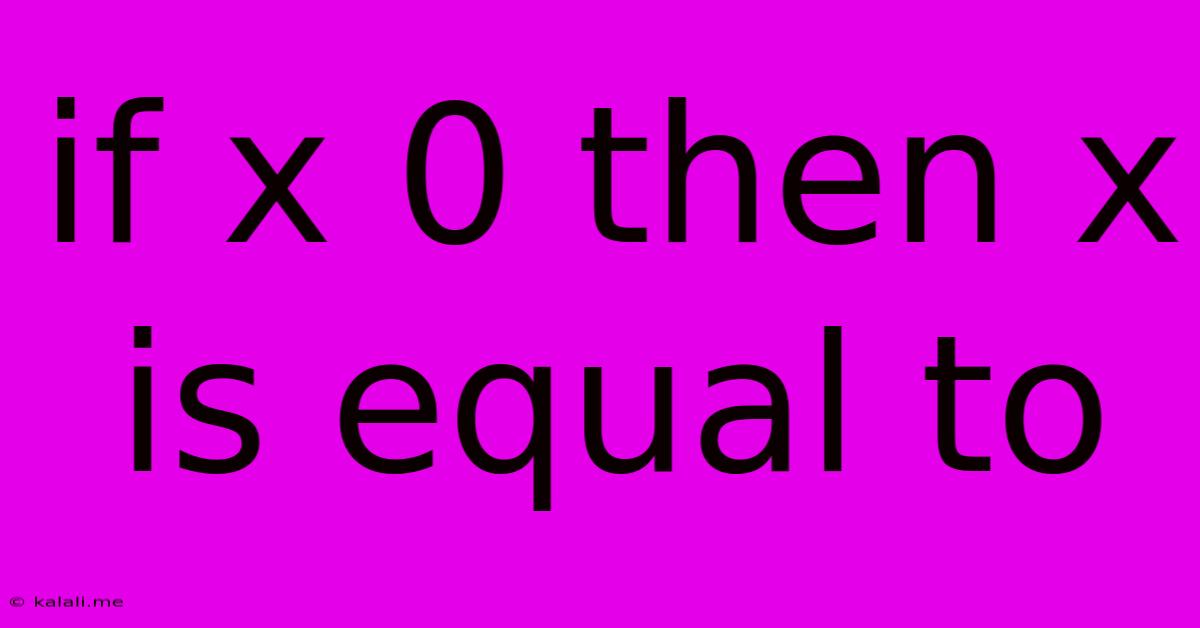If X 0 Then X Is Equal To
Kalali
Jun 13, 2025 · 3 min read

Table of Contents
If x ≠ 0, Then x is Equal To... Understanding Non-Zero Values
This article explores the implications of a non-zero value for a variable 'x' in mathematical contexts. While seemingly simple, understanding the ramifications of 'x ≠ 0' (x is not equal to zero) is crucial in various mathematical operations and problem-solving scenarios. This understanding forms the basis for many advanced concepts.
What Does x ≠ 0 Mean?
The statement "x ≠ 0" simply means that the variable 'x' can represent any numerical value except for zero. This encompasses both positive and negative numbers, as well as fractions, decimals, and even irrational numbers like π (pi) or √2 (the square root of 2). The crucial aspect is the exclusion of zero.
Why is x ≠ 0 Important?
The condition x ≠ 0 is often a prerequisite for several mathematical operations and concepts:
-
Division: The most prominent reason is the impossibility of division by zero. The expression 'a / x' is only defined if x ≠ 0. Dividing by zero is undefined in standard arithmetic because it leads to inconsistencies and paradoxes.
-
Fractions and Rational Numbers: In the fraction a/x, x represents the denominator. Since division by zero is undefined, x must be non-zero for the fraction to have a valid numerical value. This directly impacts the concept of rational numbers, which are defined as ratios of integers where the denominator is not zero.
-
Logarithms: Logarithms are only defined for positive arguments. Therefore, if you have log<sub>b</sub>(x), x must be greater than zero (x > 0), implicitly implying that x ≠ 0.
-
Inverse Functions: Many functions have inverse functions. The existence and properties of these inverses often depend on the variable being non-zero. For example, the inverse of a function might only be defined for a subset of its domain that excludes zero.
-
Limits and Calculus: In the study of limits and calculus, the behavior of a function as 'x' approaches zero is often analyzed separately from the case where 'x' is exactly zero. Many theorems and rules involving limits explicitly require that the variable not equal zero in certain neighborhoods.
Examples Illustrating x ≠ 0
Let's look at a few examples to solidify the concept:
-
Simplifying Expressions: If you have the expression (x² - 4) / (x - 2), you can simplify it to (x + 2) only if x ≠ 2 (because otherwise, you'd be dividing by zero).
-
Solving Equations: When solving an equation like 1/x = 5, you must ensure that x ≠ 0 before multiplying both sides by x to isolate x.
-
Trigonometry: In trigonometry, certain trigonometric functions might be undefined for specific angles resulting in a zero denominator. Understanding which values of the variable lead to a zero denominator is crucial for correctly evaluating the expression.
Conclusion: The Significance of Non-Zero Values
The simple statement "x ≠ 0" carries significant weight in mathematics. It's a crucial condition that safeguards against undefined operations, ensures the validity of formulas, and provides a foundation for more complex mathematical concepts. Understanding this condition is fundamental for anyone working with mathematical equations and problem-solving. It's a seemingly small detail, but mastering its implications unlocks deeper understanding across various mathematical fields.
Latest Posts
Latest Posts
-
What Is Difference Between Pound And Kg
Jun 14, 2025
-
Which Phase Of Mitosis Is The Longest
Jun 14, 2025
-
Which Hormone Is Not Produced By The Placenta
Jun 14, 2025
-
The Electrons Present In The Outermost Shell Are Called
Jun 14, 2025
-
A Bar Magnet Is Placed In A Uniform Magnetic Field
Jun 14, 2025
Related Post
Thank you for visiting our website which covers about If X 0 Then X Is Equal To . We hope the information provided has been useful to you. Feel free to contact us if you have any questions or need further assistance. See you next time and don't miss to bookmark.